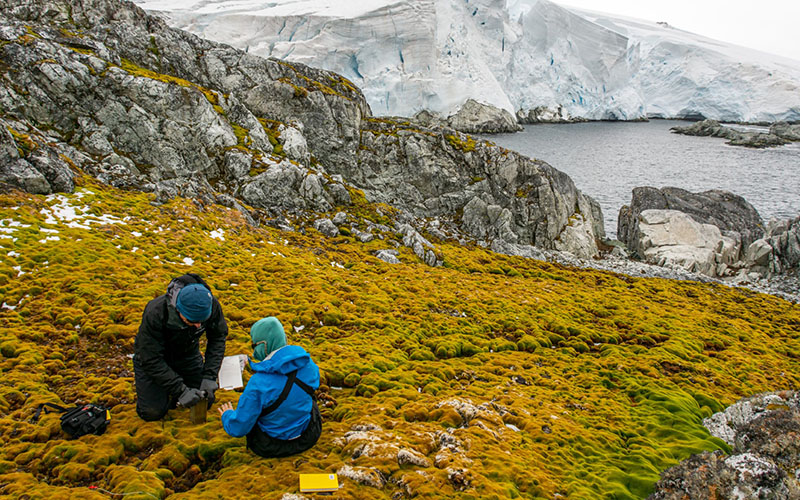Masses of MossesWhat Happens When Antarctic Peats AccretePosted April 14, 2020
As the continent warms, Antarctica is getting greener. 
Photo Credit: Mike Lucibella
Though most of Antarctica is covered by ice, moss thrives on exposed rock along the peninsula's relatively warm and moist coastline.
Plants are taking hold where glaciers once covered the landscape. Moss in particular is sprouting up in new spots where it had been previously inhospitable. While moss isn't a new arrival to the continent, its spread could mean big changes for the ecosystems of Antarctica. This year a team of researchers sailed down a stretch of the Antarctic Peninsula looking for the remains of ancient moss beds to see under what conditions moss had thrived along the continent over the last few millennia and try to peek into what the future might hold for a warmer, greener Antarctica. "Understanding what happened in the past is important for understanding what we might see in the future," said Dulcinea Groff of Lehigh University. The research is supported by the National Science Foundation, which manages the U.S. Antarctic Program. 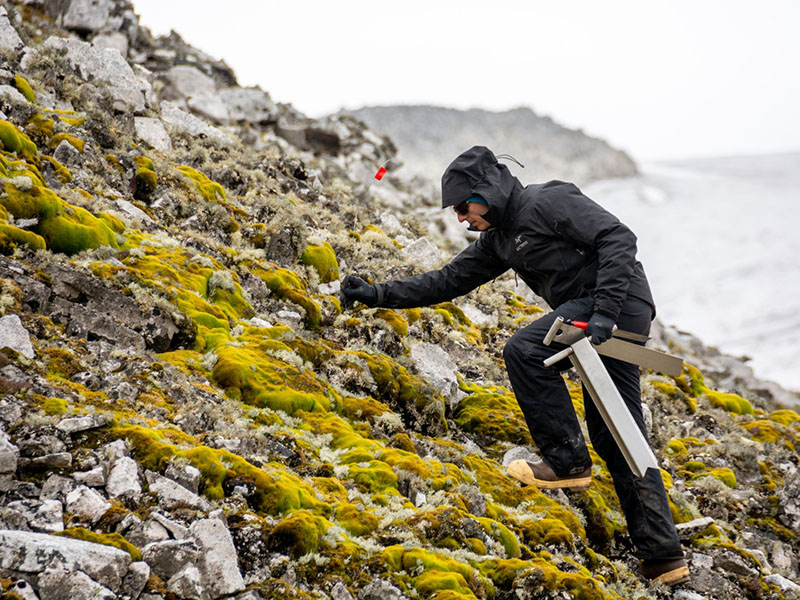
Photo Credit: Mike Lucibella
David Beilman inspects a small bed of moss, looking for buildups of deep old peat.
Deep PeatThe vast majority of Antarctica is covered in a thick ice sheet, but mosses thrive on many of the sporadic rocky patches along the northernmost coasts, particularly along the peninsula. Great green patches of moss can be found lining the shorelines and climbing the hills of many Antarctic and sub-Antarctic islands. "The mosses are the target for this study because they're the most abundant vegetation. They really are the vegetation of Antarctica," said David Beilman of the University of Hawai´i at Manoa and principal investigator on the project. "We're trying to get to know them better by looking at where they're growing how they're growing and how they're taking carbon out of the atmosphere and keeping it for a really long time." Below some of the giant moss banks are deep layers of peat, a kind of soil made up of partially decomposed organic matter from mosses that died long ago. Newer moss grows on top of its remains, creating deep layers sometimes several feet thick over hundreds or even thousands of years. "You get these unique - really only on the peninsula - peat forming aerobic moss banks and they just kind of keep going and keep going and keep going and they don't really decompose much at the bottom because it's so cold," Beilman said. Taking deep samples from some of the most massive peat banks were one of the main focuses of Beilman and his team. Because the moss only ever partially decays, these peat banks offer plain insight into ancient environment and ecosystems. "The plants are just frozen, you just don't have to do much work to reconstruct what they are because you can still see them, like little time capsules frozen there in the peat," Beilman said. "All we do is just look at the peat and the plants are right there. So we have an ecological history of what was there." Back at their labs, the team will use radiocarbon dating to precisely pinpoint the age of the bottom layers of peat. "Knowing the basal date, that tells us that the conditions were good enough for plants to survive through a growing season," Groff said. To give an even more complete picture of the ancient ecosystems, Groff collected numerous samples of "black moss," tufts of long-dead plants that lay uncovered by now-retreating glaciers. "Those mosses tell us when the glacier advanced," Groff said. "That plant was growing and taking the carbon, and then it got covered by the glacier. They stay in place so when the glacier melts away they're exposed again." 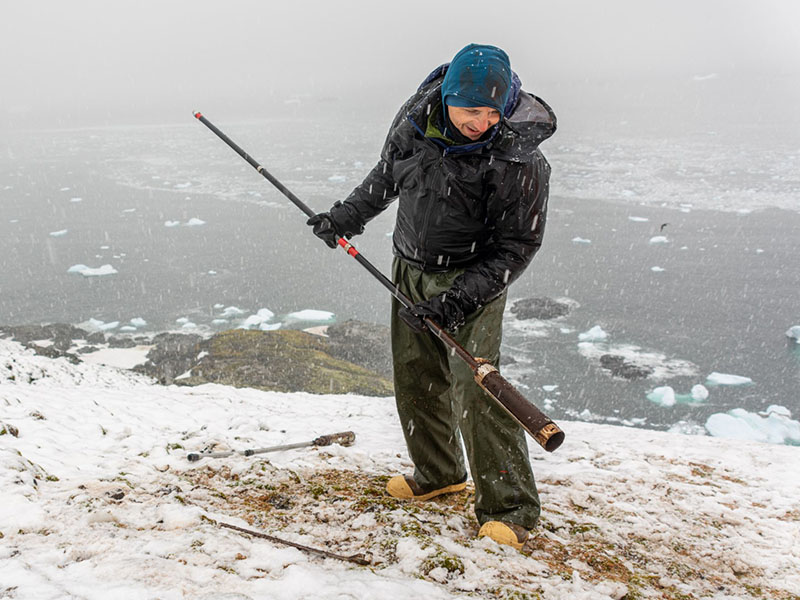
Photo Credit: Mike Lucibella
With freshly fallen snow all around, Beilman pulls out a peat core from the record-breaking depth of more than 130 centimeters at Tuxen Point.
From the research vessel Laurence M. Gould, the team visited 19 sites in five distinct regions along the west coast of the Antarctic Peninsula ranging from the South Shetland Islands in the north, to Cape Perez farther south. At Cape Tuxen, Beilman recovered a record-breaking two-meter peat core, the deepest ever sampled on the Antarctic Peninsula. The previously published record, an 82-centimeter sample cored by Beilman's team at Litchfield Island near Palmer Station in 2014, was dated to about 2,700 years old. Cryosphere to BiosphereBeilman and his team are trying to understand the history of moss growth on the continent because understanding how it's changed through different climatic conditions in the past offers insight into what the continent might look like in the future as the planet continues to warm. "The peninsula region is one of the fastest-warming places in the world," Beilman said. "Polar amplification of climate change is a well-documented phenomena. Poles and high altitudes are warming faster than the rest of the planet." 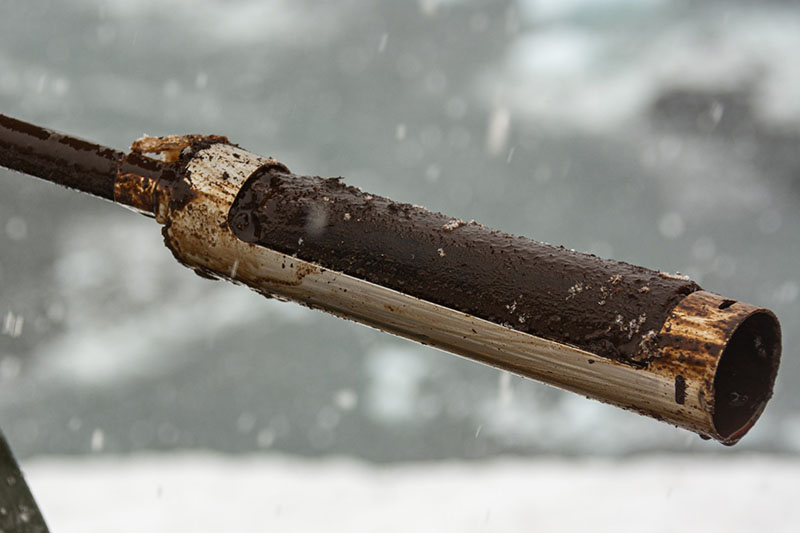
Photo Credit: Mike Lucibella
These peat samples could be hundreds or even thousands of years old, and contain clues to what the climate was like when they were growing.
This warming will likely mean less ice cover over the continent and more areas hospitable to plants. A lusher Antarctica could have impacts across the region as growing mosses capture a significant amount of carbon dioxide from the air. Mosses absorb carbon dioxide from the air and use the carbon in it to build out their leaves and stems. The large banks of mosses the team is investigating are effective carbon sinks because little of that carbon gets re-released back into the atmosphere, especially with so little decomposition happening in Antarctica. "This kind of carbon sequestration is true carbon sequestration. Once it gets into the ground, it's not going anywhere," Beilman said. "You're taking carbon out of the atmosphere and putting it somewhere out of the reach of global climate change." He estimates that over the roughly 300 square kilometers of moss-covered land in Antarctica, the plants remove about 30,000 tons of carbon from the atmosphere every year. 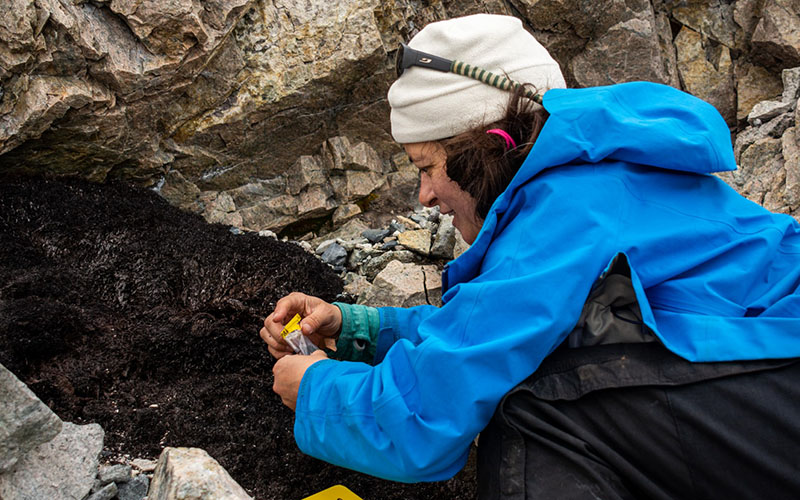
Photo Credit: Mike Lucibella
Dulcinea Groff collects a sample of black moss, dead moss that had been buried and preserved under a glacier for hundreds of years that they can use to date when the ice advanced.
"It adds up to a lot. The numbers that we get when we estimate how much carbon is being sequestered, it's substantial, and a big change for the peninsula as it warms," Beilman said. "As there's going to be more and more land available, there's going to be more and more [moss] colonization. So from a land area point of view, there should be more and more carbon being sequestered as the Antarctic Peninsula continues to green out." But how well they are able to do that in all conditions is another question Beilman and his team are looking into. Hot MossSmall unmanned aerial vehicles were also part of the team's toolkit to investigate moss growth. With them, the team was able to get a wide and detailed look at the spread of mosses across often impassible terrain. Cameras attached to the underside of the quadcopters captured visual and near-infrared images to map out the sites and help identify the different moss species growing around a region. "Plants reflect a large amount of near-infrared, and different species can have more specific reflectance than just different shades of green," said Derek Ford of the University of Hawai´i at Manoa. "From that, we can identify the plants within the imagery. We can look at the species of the different plants in the imagery." 
Photo Credit: Mike Lucibella
The team used drones to help map out the location of moss and peat banks at numerous sites along the Antarctic Peninsula.
Another camera was tuned to a longer wavelength of infrared light, which they're using to better understand how well the mosses can grow in different conditions. Direct sunlight can warm the surface of moss to much higher temperatures than the surrounding environment. Ambient air temperatures could be a cool 3 or 5 degrees Celsius, but the dark-colored moss might absorb enough radiant energy to heat its surface to 30 or 35 degrees. On the one hand this changes the heat balance of an area, with the hot moss acting as a thermal mass that reradiates that heat, impacting the ability of the area's more sensitive organisms to thrive. But it could also affect the ability of the moss itself to pull carbon dioxide out of the air. If moss gets too hot it loses its ability to efficiently grow as respiration increases. The overheating moss still is able to photosynthesize and survive, but it doesn't grow and can't pull more carbon dioxide out of the air. 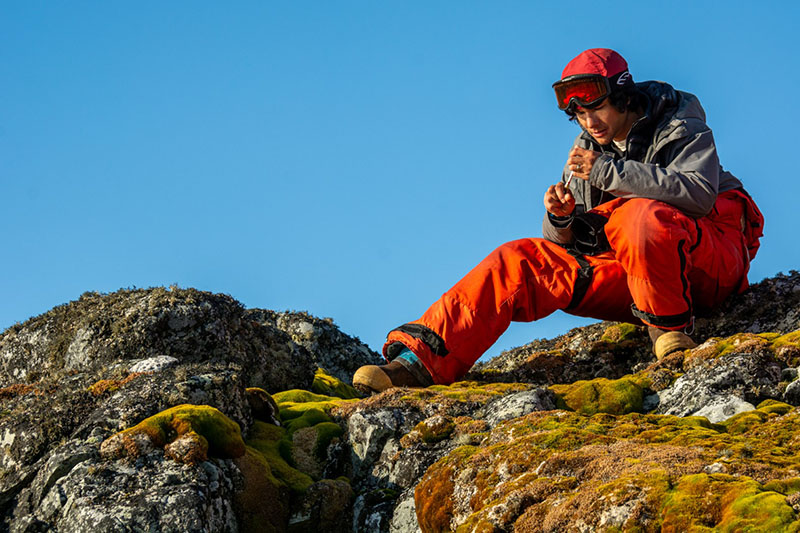
Photo Credit: Mike Lucibella
Derek Ford carefully collects samples of surface moss to bring back to the lab to better understand where the plants get their water.
The thermal camera on the drone mapped out how hot mosses can get on sunny days in a variety of locations. The team also set up two small weather stations on islands near Palmer station in part to monitor the microclimates of different sites. On them, thermal cameras are monitoring how hot specific moss patches can get in direct sunlight over a long period of time. "Those two weather stations are on different aspects," Groff said. "The one at Norsel point is a west-facing aspect, and the one at the Joubin [Islands] is a north-facing aspect. And a few years ago, they had two on Litchfield Island on the north side and one on the southwest side to sort of tease apart the microclimate." 
Photo Credit: Mike Lucibella
Ryan Newell (left) and David Beilman install sensors onto a small weather station near Palmer Station to collect data about the weather conditions that moss thrives in.
It's the team's second season on this project. Groff came down last year to set up the two weather stations and start collecting initial data. "Last year was a lot of reconnaissance," Groff said. "We were based out of Palmer Station and we just walked and looked and cored as much as we could and we also focused on the dead mosses, the black mosses in the backyard of Palmer Station." The weather stations around Palmer Station offer up detailed data about how the mosses react to changing weather conditions, different microclimates, the changing seasons and even the effects of facing different directions. The researchers are taking what they're learning about moss growth from these stations and planning to apply it more broadly to sites across the Antarctic Peninsula. "Last year was station-based and this year is ship-based," Beilman said. "It's a nice way to design a project, to have that kind of intensive time on station and this extensive time on the ship to really get around." NSF-funded research in this story: Zicheng Yu, Lehigh University, Award No. 1745068, David Beilman, University of Hawai´i at Manoa, Award No. 1745082. |



For USAP Participants |
For The Public |
For Researchers and EducatorsContact UsU.S. National Science FoundationOffice of Polar Programs Geosciences Directorate 2415 Eisenhower Avenue, Suite W7100 Alexandria, VA 22314 Sign up for the NSF Office of Polar Programs newsletter and events. Feedback Form |

